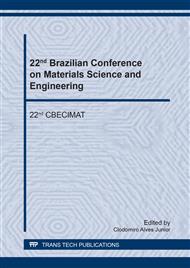[1]
K. Setshedi, J. Ren, O. Aoyi, M.S. Onyango: Int. J. Phys. Sci. Vol. 7 (1) (2012), p.63.
Google Scholar
[2]
W. Ma, N. Zhao, G. Yang, L. Tian, R. Wang: Desalination Vol. 2681 (3) (2011), p.20.
Google Scholar
[3]
Y. Yang, n. Gao, W. Chu, Y. Zhang, Y. Ma: J. Hazard. Mater. Vol. 9 (210) (2012), p.318.
Google Scholar
[4]
F. Cavani, F. Trifiró, A. Vaccari: Catal. Today Vol. 11 (1991), p.177.
Google Scholar
[5]
L. Conceição, S.B.C. Pergher: Quim. Nova Vol. 30 (5) (2007), p.1077.
Google Scholar
[6]
M. Kato, M.D. Azimi, S.H. Fayaz, M.D. Shah, M.Z. Hoque, N. Hamajima, S. Ohnuma, T. Ohtsuka, M. Maeda, M. Yoshinaga: Chemosphere Vol. 165 (2016), p.27.
DOI: 10.1016/j.chemosphere.2016.08.124
Google Scholar
[7]
M.N. Timofeeva, A.E. Kapustin, V.N. Panchenko, E.O. Butenko, V.V. Krupskaya, A. Gil, M.A. Vicente: J. Mol. Catal. A Chem. Vol. 423 (2016), p.22.
Google Scholar
[8]
L.I. Ardhayantia, S.J. Santosa: Procedia Chem. Vol. 148 (2016), p.1380.
Google Scholar
[9]
M. Bolognini, F. Cavani, D. Scagliarini, C. Flego, C. Perego, M. Saba: Catal. Today Vol. 75 (2002), p.103.
DOI: 10.1016/s0920-5861(02)00050-0
Google Scholar
[10]
B. Wiyantokoa, P. Kurniawatia, T.E. Purbaningtias, I. Fatimah: Procedia Chem. Vol. 17 (2015), p.21.
Google Scholar
[11]
T. Baskaran, J. Christopher, A. Sakthivel: RSC Adv. Vol. 5 (2015), p.98875.
Google Scholar
[12]
C.W. Beck: Am. Mineral Vol. 35 (1950), p.1006.
Google Scholar
[13]
F. Silvério: Springer Plus Vol. 2 (211) (2013), p.1.
Google Scholar
[14]
F.M Labajos, V. Rives: Inorg. Chem. Vol. 34 (1996), p.5313.
Google Scholar
[15]
A.S. Prakash, V. Kamath, M.S. Hegde: Mater. Res. Bull. Vol. 35 (2000), p.2189.
Google Scholar
[16]
D.M. Roy, R. Roy, E.F. Osborn: Am. J. Sci. Vol. 251 (1953), p.337.
Google Scholar
[17]
N.S. Puttaswamy, V. Kamath: J. Mater. Chem. Vol. 7 (9) (1997), p. (1941).
Google Scholar
[18]
M. Belloto, B. Rebours, O. Clause, J. Lynch, D. Bazin, E. Elkaïn: J. Phys. Chem. US Vol. 100 (20) (1996), p.8535.
Google Scholar
[19]
K. Ebitani, K. Motokura, K. Mori, T. Mizugaki, K. Kaneda: J. Org. Chem. Vol. 71 (2006), p.5440.
Google Scholar
[20]
JCPDS - Joint Committee on Powder Diffraction Standards/International Center for Diffraction Data, Pennsylvania, Powder Diffraction File (2003).
Google Scholar
[21]
G. Socrates: Infrared and Raman Characteristic Group Frequencies. (John Wiley & Sons 3ª ed. Chichester, 2004).
Google Scholar
[22]
H. Marsh, B. Rand: J. Colloid Interf. Sci. Vol. 33 (1970), p.478.
Google Scholar
[23]
J. Landers, G.Y. Gor, A.V. Neimark: Colloid Surface A Vol. 437 (2013), p.33.
Google Scholar


